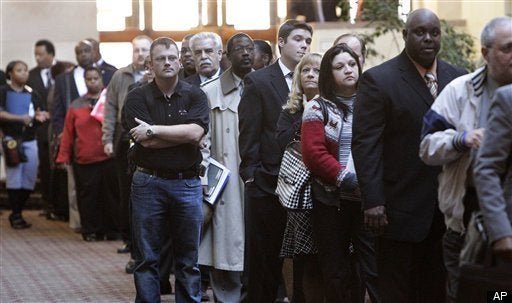
The American economy sped up in the last three months of 2010, but economic growth is still dramatically short of where it needs to be to make a significant dent in the unemployment rate.
Gross domestic product -- the output of goods and services produced by the American economy -- grew at a rate of 3.2 percent annual rate in the last quarter of 2010 according to the Commerce Department's report.
This is good news, but not, as Josh Biven, an economist at the Economic Policy Institute, sees it, good enough. "The headline number -- the 3.2 percent growth -- if we sustain that rate of growth throughout 2011 that would do very little to push down the unemployment rate," Biven said. Three percent growth is what you need just to keep the economy stable.
To see any kind of real improvement, as Biven calculates, the GDP would need to be improving at a rate of 5 percent, month-over-month for an entire year -- and that would only lower the unemployment rate by one percentage point. "The growth is nowhere near fast enough to start pushing down the overall unemployment," he said.
Bart van Ark, chief economist at the Conference Board, likewise does not see much to celebrate. In a widely circulated email, van Ark wrote:
Continued woes in the housing market and weakness in the labor market will prevail throughout 2011. We anticipate a post-holiday pullback in consumer spending, a rise in the personal savings rate, further cuts in spending by state and local municipalities, and a deceleration in business investment in inventories in the current and next quarters. Consequently, economic growth will register only a sluggish 2 percent in the first half of 2011.
One positive sign inside the Commerce Department's report was picked up by the Wall Street Journal's Kelly Evans, who tweeted:
Wow. Excluding inventories, GDP up 7.1% in Q4 - most since 1984. Now that's more like a recovery!
(Evans was referring to "real final sales," which discounts the effect that increased inventory levels -- essentially unsold goods -- has on GDP.)
But Biven, at least, doesn't see that 7.1% percent as a very accurate indicator of economic recovery.
"The 3.2 percent is the better measure of the trend of the economy," he said. "I don't expect inventories are going to take away a bunch of growth again in coming quarters. There are reasons to think the 3.2 percent number is a little closer to what the economy is actually doing right now."
Steve Benen, at Political Animal, summarizes the situation nicely:
While better growth is obviously good news, 3.2% is still only modest growth. Under normal circumstances, this would point to a fairly healthy economy, humming right along. But given the severity of the Great Recession, our circumstances are anything but normal -- to have a robust recovery and make a real dent in the unemployment rate, we'll still need to do better than this.
Accelerating growth is encouraging, but if you hear policymakers and pundits today use this as an excuse to justify hitting the brakes, please know that they're completely wrong. We're slowly getting out of a ditch -- pursuing massive budget cuts, taking money out of the economy, and deliberately putting people out of work (i.e., the vision embraced by House Republicans) would very likely push us backwards in a hurry.
